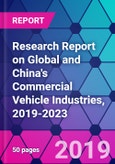According to the author, compared with air transport, rail transport, water transport and other modes of transport, highway transport has a door-to-door advantage and high-cost performance. By the end of 2018, the length of China’s highways totaled 4,846,500 kilometers, increasing by 73,100 kilometers as compared to 2017; road density reached 50.48 km/100 sq.km., increasing by 0.76 km/100 sq.km. as compared to 2017; the freight traffic of highways reached 39.57 billion tons, increasing by 7.30% YOY; the freight turnover of highways reached 7,124.92 billion ton-km, increasing by 6.70% YOY. The growing highway traffic boosts the demand for commercial vehicles.
The production volume of commercial vehicles in China increased from 3,791,000 units in 2014 to 4,371,000 units in 2018. Although it showed a YOY decrease in 2015, it kept rising from 2016 to 2018. Especially in 2018 when the production and sales of automobiles declined, the production and sales of commercial vehicles both achieved growth.
According to the author, China’s commercial market is deeply influenced by policies. For example, from 2014 to 2015, the Chinese government released some restrictive policies on commercial vehicles, which led to a decline in commercial vehicle production. In 2016, the government started to subsidize the commercial vehicle industry and took other encouraging measures, which pushed up the production of commercial vehicles to some extent. When the tolls on highways began to be collected based on actual load, the sales volume of light trucks increased. When the emission standards were raised, enterprises accelerated technological innovation and the sales volume of new energy commercial vehicles increased.
The author expects that, with the improvement of road networks and the development of rural roads, both the freight traffic and passenger traffic of China’s highways will continue to grow from 2019 to 2023, which will stimulate the demand for commercial vehicles. In 2018, the fixed-asset investment in China reached CNY 63,563.60 billion, increasing by 5.90% YOY. The growth rate of fixed-asset investment has a great impact on the development of China’s commercial vehicle industry, especially the truck sub-industry. To ensure annual GDP growth rate of no less than 6%, from 2019 to 2023, the Chinese government will certainly increase investment in fixed assets, especially in infrastructure projects, which will drive the demand for commercial vehicles.
Topics Covered
- Economic and policy environment for the commercial vehicle industry
- Analysis of supply of and demand for commercial vehicles
- Manufacturing costs and prices of commercial vehicles in China
- Analysis of import and export of commercial vehicles in China
- Competition on China's commercial vehicle market
- Major commercial vehicle manufacturers in China
- Driving forces and market opportunities for the commercial vehicle industry
- Threats and challenges to the commercial vehicle industry
- Forecast on the supply of and demand for commercial vehicles in China from 2019 to 2023
Table of Contents
Samples

LOADING...
Companies Mentioned
- Anhui Hualing Automobile Co., Ltd.
- Anhui Jianghuai Automobile Group Corp., Ltd.
- Baoding Changan Bus Manufacturing Co., Ltd.
- Beiqi Foton Motor Co., Ltd.
- Chery Automobile Co., Ltd.
- China FAW Group Corporation
- Chongqing Changan Automobile Co., Ltd.
- CNHTC Jinan Truck Co., Ltd.
- Dayun Automobile Co., Ltd.
- Dongfeng Motor Corporation
- Jiangling Motors Co., Ltd.
- Nanjing Iveco Automobile Co., Ltd.
- Renault Brilliance Jinbei Automotive Co., Ltd.
- SAIC Iveco Hongyan Commercial Vehicle Co., Ltd.
- SAIC Maxus Automotive Co., Ltd.
- Shaanxi Automobile Holding Group Co., Ltd.
- Shandong Kama Automobile Manufacturing Co., Ltd.
- Shenyang Jinbei Automotive Co., Ltd.
- Xiamen Golden Dragon Bus Co., Ltd.
- Xiamen King Long United Automotive Industry Co., Ltd.
- Xuzhou XCMG Automobile Manufacturing Co., Ltd.
- Zhengzhou Yutong Bus Co., Ltd.
- Zhongtong Bus Holding Co., Ltd.
Methodology
Background research defines the range of products and industries, which proposes the key points of the research. Proper classification will help clients understand the industry and products in the report.
Secondhand material research is a necessary way to push the project into fast progress. The analyst always chooses the data source carefully. Most secondhand data they quote is sourced from an authority in a specific industry or public data source from governments, industrial associations, etc. For some new or niche fields, they also "double-check" data sources and logics before they show them to clients.
Primary research is the key to solve questions, which largely influence the research outputs. The analyst may use methods like mathematics, logical reasoning, scenario thinking, to confirm key data and make the data credible.
The data model is an important analysis method. Calculating through data models with different factors weights can guarantee the outputs objective.
The analyst optimizes the following methods and steps in executing research projects and also forms many special information gathering and processing methods.
1. Analyze the life cycle of the industry to understand the development phase and space.
2. Grasp the key indexes evaluating the market to position clients in the market and formulate development plans
3. Economic, political, social and cultural factors
4. Competitors like a mirror that reflects the overall market and also market differences.
5. Inside and outside the industry, upstream and downstream of the industry chain, show inner competitions
6. Proper estimation of the future is good guidance for strategic planning.

LOADING...








